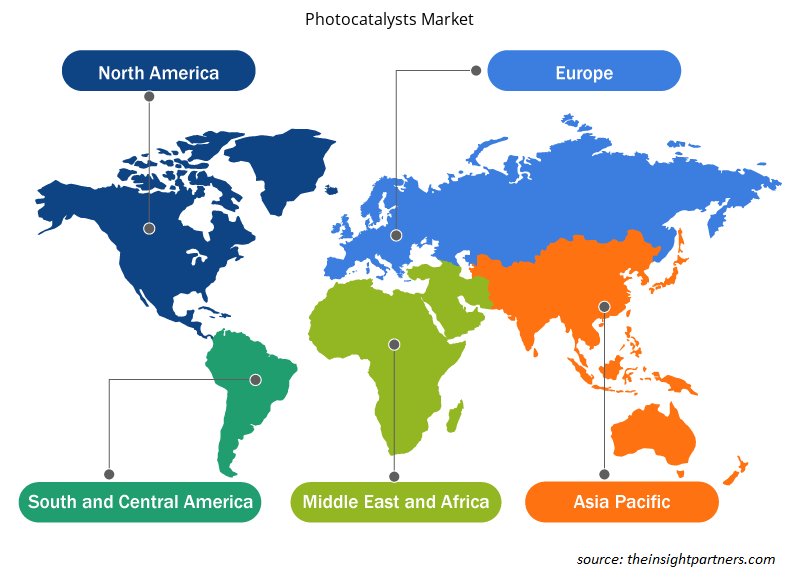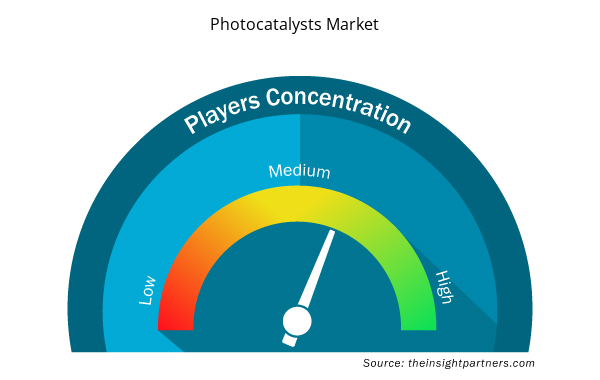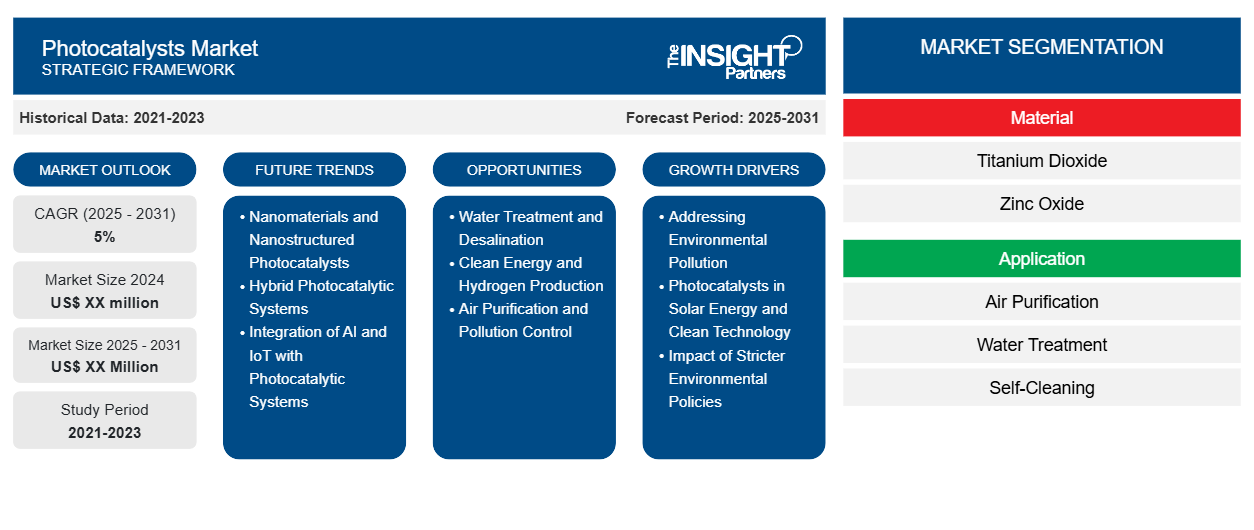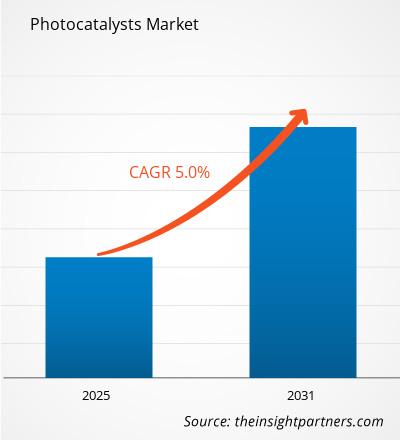Le marché des photocatalyseurs devrait enregistrer un TCAC de 5 % de 2023 à 2031, avec une taille de marché passant de XX millions USD en 2023 à XX millions USD d'ici 2031.
Le rapport sur le marché des photocatalyseurs est segmenté par matériau (dioxyde de titane, oxyde de zinc et autres). Le marché est segmenté en fonction de l'application (purification de l'air, traitement de l'eau, autonettoyage et autres). L'analyse globale est ensuite décomposée au niveau régional et par principaux pays. La taille du marché et les prévisions aux niveaux mondial, régional et national pour tous les segments de marché clés sont couvertes dans le cadre du périmètre. Le rapport offre la valeur en USD pour l'analyse, les segments, les régions et les pays ci-dessus. Le rapport couvre les tendances du marché, ainsi que la dynamique du marché telle que les moteurs, les contraintes et les opportunités clés. Le rapport couvre également le paysage industriel et l'analyse de la concurrence couvrant la concentration du marché, l'analyse de la carte thermique, les principaux acteurs et les développements récents du marché.
Objectif du rapport
Le rapport Photocatalysts Market de The Insight Partners vise à décrire le paysage actuel et la croissance future, les principaux facteurs moteurs, les défis et les opportunités. Cela fournira des informations à diverses parties prenantes commerciales, telles que :
- Fournisseurs/fabricants de technologie : pour comprendre l’évolution de la dynamique du marché et connaître les opportunités de croissance potentielles, leur permettant de prendre des décisions stratégiques éclairées.
- Investisseurs : Effectuer une analyse complète des tendances concernant le taux de croissance du marché, les projections financières du marché et les opportunités qui existent tout au long de la chaîne de valeur.
- Organismes de réglementation : Réglementer les politiques et surveiller les activités du marché dans le but de minimiser les abus, de préserver la confiance des investisseurs et de maintenir l’intégrité et la stabilité du marché.
Segmentation du marché des photocatalyseurs
Matériel
- Dioxyde de titane
- Oxyde de zinc
Application
- Purification de l'air
- Traitement de l'eau
- Autonettoyant
Personnalisez ce rapport en fonction de vos besoins
Vous bénéficierez d'une personnalisation gratuite de n'importe quel rapport, y compris de certaines parties de ce rapport, d'une analyse au niveau des pays, d'un pack de données Excel, ainsi que de superbes offres et réductions pour les start-ups et les universités.
- Obtenez les principales tendances clés du marché de ce rapport.Cet échantillon GRATUIT comprendra une analyse de données, allant des tendances du marché aux estimations et prévisions.
Facteurs de croissance du marché des photocatalyseurs
- Lutte contre la pollution environnementale : les préoccupations environnementales et la durabilité sont à l'origine de l'adoption de photocatalyseurs. Depuis que les effets de serre et la pollution environnementale sont devenus une réalité, avec une prise de conscience croissante, les photocatalyseurs ont été développés pour purifier l'eau et l'air et faire réagir les produits chimiques avec l'énergie lumineuse. Ainsi, ils aident à développer des solutions durables pour contrôler la pollution et décomposer les polluants nocifs et les gaz à effet de serre.photocatalysts. Since greenhouse effects and environmental pollution have become a reality, with increasing awareness, photocatalysts have developed to purify water and air and react chemicals with light energy. Thus, these help in developing sustainable solutions for controlling pollution and decomposing harmful pollutants and greenhouse gases.
- Photocatalyseurs dans l'énergie solaire et les technologies propres : La présence de photocatalyseurs est essentielle au développement des technologies basées sur l'énergie solaire, en particulier dans le cas de la production d'hydrogène à partir de l'eau. De plus, compte tenu de la tendance croissante à l'utilisation de sources d'énergie renouvelables, le besoin de photocatalyseurs capables de collecter et de convertir l'énergie solaire en formes chimiques augmente également. Une telle technologie non seulement renforce la quête d'énergie propre, mais garantit également que l'énergie solaire peut être stockée pour une utilisation ultérieure, ce qui est par exemple, en ce qui concerne cette énergie renouvelable, très important. in Solar Energy and Clean Technology: The presence of photocatalysts is essential in growing solar energy-based technologies, especially in the case of the generation of hydrogen from water. Moreover, considering the increasing trends is the use of renewable energy sources, the need for photocatalysts capable of collecting and converting solar energy into chemical forms is also growing. Such a technology not only augments the clean energy pursuit but also ensures that solar energy can be stored for utilization at a later date, which is for example, in relation to this renewable, quite important.
- Impact des politiques environnementales plus strictes : Le monde connaît une adoption croissante de politiques environnementales plus strictes. Les mesures conçues pour réduire les émissions de carbone, améliorer la qualité de l'air et promouvoir l'utilisation de technologies propres encouragent l'utilisation de photocatalyseurs dans les applications industrielles et commerciales. Cela couvre des domaines tels que les systèmes de nettoyage automobile, la gestion des eaux usées et des déchets industriels, ce qui augmente à son tour l'offre de systèmes photocatalytiques.photocatalysts in industrial and commercial applications. This covers areas including automotive scrubbing systems, wastewater management, and industrial waste, which in turn increases the supply of photocatalytic systems.
Tendances futures du marché des photocatalyseurs
- Nanomatériaux et photocatalyseurs nanostructurés : Il est envisagé que les photocatalyseurs seront plus efficaces avec l'inclusion de nanomatériaux dans la fabrication de leurs composants. Il a été rapporté que les photocatalyseurs nanostructurés photoactifs augmentent la capacité de captage de la lumière et la cinétique des processus. Il est raisonnable de s'attendre à ce que l'on se concentre sur l'invention de nouveaux types de nano-photocatalyseurs qui se généraliseront et développeront des applications abordables mais à faible consommation d'énergie, en particulier pour le nettoyage de l'environnement et la production d'électricité.
- Systèmes photocatalytiques hybrides : Les systèmes photocatalytiques hybrides sont les plus innovants dans cette catégorie. Ils combinent l'application de photocatalyseurs entre eux et avec d'autres dispositifs, par exemple des piles à combustible, des systèmes intra-batteries et des systèmes biologiques. Ces systèmes hybrides ont le potentiel phénoménal d'améliorer les processus de conversion d'énergie et de réduction des émissions, ce qui a par conséquent poussé les industries et les utilisateurs vers des solutions avancées.
- Intégration de l'IA et de l'IoT aux systèmes photocatalytiques : la convergence de l'intelligence artificielle et de l'Internet des objets avec les systèmes photocatalytiques est une tendance croissante. Le développement de systèmes photocatalytiques intelligents capables d'avoir un fonctionnement plus complexe et une capacité de surveillance en temps réel est en cours pour des applications telles que la purification de l'air, le traitement des déchets et la conversion de l'énergie solaire. Ces systèmes promettent des fonctionnalités plus efficaces, évolutives et flexibles.
Opportunités de marché pour les photocatalyseurs
- Traitement et dessalement de l'eau : La pénurie croissante d'eau à l'échelle mondiale constitue déjà une menace, mais elle crée une opportunité de marché évidente, en particulier pour les photocatalyseurs parmi tous les systèmes utilisés dans le traitement et le dessalement de l'eau. En effet, les matériaux photocatalytiques sont capables de dégrader à la fois les polluants et les agents pathogènes présents dans l'eau, ce qui permet de garantir l'approvisionnement en eau potable des pays développés et en développement.
- Énergie propre et production d'hydrogène : L'utilisation de photocatalyseurs peut également être envisagée dans un certain nombre d'applications, notamment le stockage d'énergie et la production d'hydrogène à partir d'énergie propre via la photolyse de l'eau, entre autres. Avec l'expansion de la technologie de l'énergie propre, il semble que l'économie de l'hydrogène fera du marché croissant des photocatalyseurs pour la synthèse et le stockage de l'hydrogène un élément clé du spectre des formes de ressources renouvelables.
- Purification de l'air et contrôle de la pollution : Il est désormais de notoriété publique que les niveaux de pollution de l'air dans les villes sont scandaleusement élevés. Par conséquent, il existe de plus en plus de possibilités d'utiliser des matériaux photocatalytiques dans l'enveloppe urbaine, comme les surfaces des bâtiments sur site, comme moyen d'éliminer la pollution de l'air. L'utilisation de revêtements photocatalytiques dans les matériaux de construction et de construction est également un exemple de segment de marché émergent, compte tenu de son fort potentiel de croissance.
Aperçu régional du marché des photocatalyseurs
Les tendances et facteurs régionaux influençant le marché des photocatalyseurs tout au long de la période de prévision ont été expliqués en détail par les analystes d’Insight Partners. Cette section traite également des segments et de la géographie du marché des photocatalyseurs en Amérique du Nord, en Europe, en Asie-Pacifique, au Moyen-Orient et en Afrique, ainsi qu’en Amérique du Sud et en Amérique centrale.

- Obtenez les données régionales spécifiques au marché des photocatalyseurs
Portée du rapport sur le marché des photocatalyseurs
| Attribut de rapport | Détails |
|---|---|
| Taille du marché en 2023 | XX millions de dollars américains |
| Taille du marché d'ici 2031 | XX millions de dollars américains |
| Taux de croissance annuel composé mondial (2023-2031) | 5% |
| Données historiques | 2021-2022 |
| Période de prévision | 2024-2031 |
| Segments couverts | Par matériau
|
| Régions et pays couverts | Amérique du Nord
|
| Leaders du marché et profils d'entreprises clés |
|
Densité des acteurs du marché des photocatalyseurs : comprendre son impact sur la dynamique des entreprises
Le marché des photocatalyseurs connaît une croissance rapide, tirée par la demande croissante des utilisateurs finaux en raison de facteurs tels que l'évolution des préférences des consommateurs, les avancées technologiques et une plus grande sensibilisation aux avantages du produit. À mesure que la demande augmente, les entreprises élargissent leurs offres, innovent pour répondre aux besoins des consommateurs et capitalisent sur les tendances émergentes, ce qui alimente davantage la croissance du marché.
La densité des acteurs du marché fait référence à la répartition des entreprises ou des sociétés opérant sur un marché ou un secteur particulier. Elle indique le nombre de concurrents (acteurs du marché) présents sur un marché donné par rapport à sa taille ou à sa valeur marchande totale.
Les principales entreprises opérant sur le marché des photocatalyseurs sont :
- BASF SE
- Millénaire Vert, Inc.
- Ishihara Sangyo Kaisha, Ltd.
- Société JSR
- KRONOS Worldwide, Inc.
Avis de non-responsabilité : les sociétés répertoriées ci-dessus ne sont pas classées dans un ordre particulier.

- Obtenez un aperçu des principaux acteurs du marché des photocatalyseurs
Principaux arguments de vente
- Couverture complète : Le rapport couvre de manière exhaustive l’analyse des produits, des services, des types et des utilisateurs finaux du marché des photocatalyseurs, offrant un paysage holistique.
- Analyse d’experts : Le rapport est compilé sur la base d’une compréhension approfondie des experts et analystes du secteur.
- Informations à jour : Le rapport garantit la pertinence commerciale en raison de sa couverture des informations récentes et des tendances des données.
- Options de personnalisation : ce rapport peut être personnalisé pour répondre aux exigences spécifiques du client et s'adapter parfaitement aux stratégies commerciales.
Le rapport de recherche sur le marché des photocatalyseurs peut donc aider à ouvrir la voie au décodage et à la compréhension du scénario de l’industrie et des perspectives de croissance. Bien qu’il puisse y avoir quelques préoccupations valables, les avantages globaux de ce rapport ont tendance à l’emporter sur les inconvénients.
- Analyse historique (2 ans), année de base, prévision (7 ans) avec TCAC
- Analyse PEST et SWO
- Taille du marché Valeur / Volume - Mondial, Régional, Pays
- Industrie et paysage concurrentiel
- Ensemble de données Excel


- Smart Grid Sensors Market
- Helicopters Market
- Drain Cleaning Equipment Market
- Emergency Department Information System (EDIS) Market
- Webbing Market
- Semiconductor Metrology and Inspection Market
- Bathroom Vanities Market
- Playout Solutions Market
- Hot Melt Adhesives Market
- Oxy-fuel Combustion Technology Market

Report Coverage
Revenue forecast, Company Analysis, Industry landscape, Growth factors, and Trends

Segment Covered
This text is related
to segments covered.

Regional Scope
North America, Europe, Asia Pacific, Middle East & Africa, South & Central America

Country Scope
This text is related
to country scope.
Questions fréquemment posées
Nanotechnology integration is expected to be the key market trends.
Based on geography, Asia Pacific held the largest share of the photocatalysts market due to the strong growth of the water treatment industry in the region.
Based on application, the water treatment segment is expected to witness the fastest growth during the forecast period.
Advancements in solar energy utilization is driving the market growth.
TOTO Corporation, JSR Corporation, KRONOS Worldwide Inc, CRISTAL, TiPE, OSAKA Titanium Technologies Co Ltd, Showa Denko K.K, Nanoxo, The Chemours Company, and PHOTOCAT A/S are the key players operating in the photocatalysts market.
The Photocatalysts Market is estimated to witness a CAGR of 5% from 2023 to 2031
Trends and growth analysis reports related to Chemicals and Materials : READ MORE..
The List of Companies
- BASF SE
- Green Millennium, Inc.
- Ishihara Sangyo Kaisha, Ltd.
- JSR Corporation
- KRONOS Worldwide, Inc.
- Nanoptek Corp.
- OSAKA Titanium technologies Co., Ltd. (OTC)
- Showa Denko K. K.
- TitanPE Technologies, Inc. (TiPE)
- Toto Ltd.
The Insight Partners performs research in 4 major stages: Data Collection & Secondary Research, Primary Research, Data Analysis and Data Triangulation & Final Review.
- Data Collection and Secondary Research:
As a market research and consulting firm operating from a decade, we have published and advised several client across the globe. First step for any study will start with an assessment of currently available data and insights from existing reports. Further, historical and current market information is collected from Investor Presentations, Annual Reports, SEC Filings, etc., and other information related to company’s performance and market positioning are gathered from Paid Databases (Factiva, Hoovers, and Reuters) and various other publications available in public domain.
Several associations trade associates, technical forums, institutes, societies and organization are accessed to gain technical as well as market related insights through their publications such as research papers, blogs and press releases related to the studies are referred to get cues about the market. Further, white papers, journals, magazines, and other news articles published in last 3 years are scrutinized and analyzed to understand the current market trends.
- Primary Research:
The primarily interview analysis comprise of data obtained from industry participants interview and answers to survey questions gathered by in-house primary team.
For primary research, interviews are conducted with industry experts/CEOs/Marketing Managers/VPs/Subject Matter Experts from both demand and supply side to get a 360-degree view of the market. The primary team conducts several interviews based on the complexity of the markets to understand the various market trends and dynamics which makes research more credible and precise.
A typical research interview fulfils the following functions:
- Provides first-hand information on the market size, market trends, growth trends, competitive landscape, and outlook
- Validates and strengthens in-house secondary research findings
- Develops the analysis team’s expertise and market understanding
Primary research involves email interactions and telephone interviews for each market, category, segment, and sub-segment across geographies. The participants who typically take part in such a process include, but are not limited to:
- Industry participants: VPs, business development managers, market intelligence managers and national sales managers
- Outside experts: Valuation experts, research analysts and key opinion leaders specializing in the electronics and semiconductor industry.
Below is the breakup of our primary respondents by company, designation, and region:

Once we receive the confirmation from primary research sources or primary respondents, we finalize the base year market estimation and forecast the data as per the macroeconomic and microeconomic factors assessed during data collection.
- Data Analysis:
Once data is validated through both secondary as well as primary respondents, we finalize the market estimations by hypothesis formulation and factor analysis at regional and country level.
- Macro-Economic Factor Analysis:
We analyse macroeconomic indicators such the gross domestic product (GDP), increase in the demand for goods and services across industries, technological advancement, regional economic growth, governmental policies, the influence of COVID-19, PEST analysis, and other aspects. This analysis aids in setting benchmarks for various nations/regions and approximating market splits. Additionally, the general trend of the aforementioned components aid in determining the market's development possibilities.
- Country Level Data:
Various factors that are especially aligned to the country are taken into account to determine the market size for a certain area and country, including the presence of vendors, such as headquarters and offices, the country's GDP, demand patterns, and industry growth. To comprehend the market dynamics for the nation, a number of growth variables, inhibitors, application areas, and current market trends are researched. The aforementioned elements aid in determining the country's overall market's growth potential.
- Company Profile:
The “Table of Contents” is formulated by listing and analyzing more than 25 - 30 companies operating in the market ecosystem across geographies. However, we profile only 10 companies as a standard practice in our syndicate reports. These 10 companies comprise leading, emerging, and regional players. Nonetheless, our analysis is not restricted to the 10 listed companies, we also analyze other companies present in the market to develop a holistic view and understand the prevailing trends. The “Company Profiles” section in the report covers key facts, business description, products & services, financial information, SWOT analysis, and key developments. The financial information presented is extracted from the annual reports and official documents of the publicly listed companies. Upon collecting the information for the sections of respective companies, we verify them via various primary sources and then compile the data in respective company profiles. The company level information helps us in deriving the base number as well as in forecasting the market size.
- Developing Base Number:
Aggregation of sales statistics (2020-2022) and macro-economic factor, and other secondary and primary research insights are utilized to arrive at base number and related market shares for 2022. The data gaps are identified in this step and relevant market data is analyzed, collected from paid primary interviews or databases. On finalizing the base year market size, forecasts are developed on the basis of macro-economic, industry and market growth factors and company level analysis.
- Data Triangulation and Final Review:
The market findings and base year market size calculations are validated from supply as well as demand side. Demand side validations are based on macro-economic factor analysis and benchmarks for respective regions and countries. In case of supply side validations, revenues of major companies are estimated (in case not available) based on industry benchmark, approximate number of employees, product portfolio, and primary interviews revenues are gathered. Further revenue from target product/service segment is assessed to avoid overshooting of market statistics. In case of heavy deviations between supply and demand side values, all thes steps are repeated to achieve synchronization.
We follow an iterative model, wherein we share our research findings with Subject Matter Experts (SME’s) and Key Opinion Leaders (KOLs) until consensus view of the market is not formulated – this model negates any drastic deviation in the opinions of experts. Only validated and universally acceptable research findings are quoted in our reports.
We have important check points that we use to validate our research findings – which we call – data triangulation, where we validate the information, we generate from secondary sources with primary interviews and then we re-validate with our internal data bases and Subject matter experts. This comprehensive model enables us to deliver high quality, reliable data in shortest possible time.


 Obtenez un échantillon gratuit pour ce rapport
Obtenez un échantillon gratuit pour ce rapport